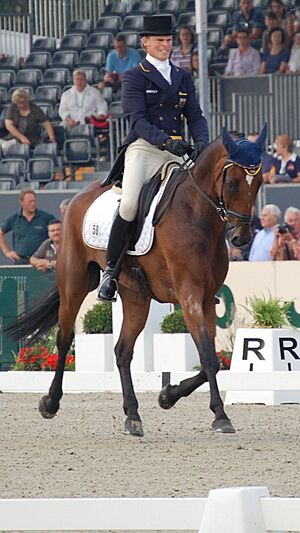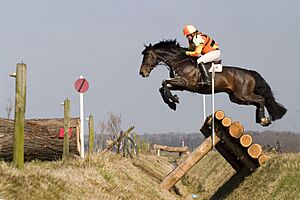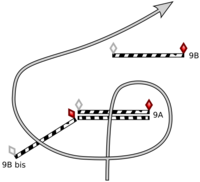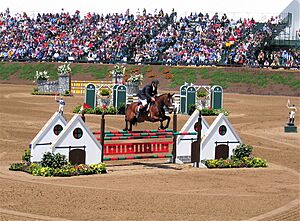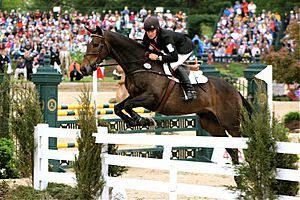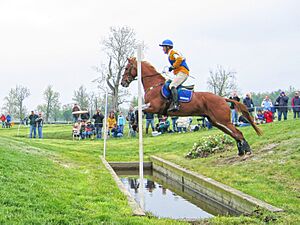Eventing facts for kids
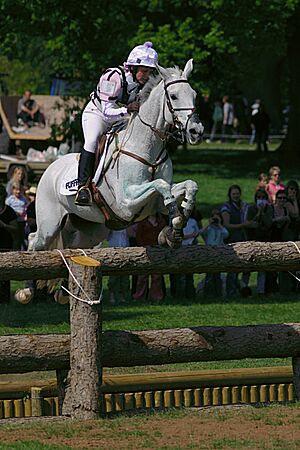
The cross-country phase of Eventing
|
|
| Highest governing body | International Federation for Equestrian Sports (FEI) |
|---|---|
| Nicknames |
|
| Characteristics | |
| Team members | Individual and team at international levels |
| Mixed-sex | Yes |
| Type | Outdoor |
| Equipment |
|
| Venue |
|
| Presence | |
| Country or region | Worldwide |
| Olympic | 1912 |
Eventing is an exciting horse sport where one horse and rider team competes in three different challenges. It's often called three-day eventing or horse trials. The three parts are dressage, cross-country, and show jumping. This sport began as a test for cavalry (military horses and riders) to show they could do many types of riding.
Eventing competitions can be a one-day event (ODE) where all three parts happen on the same day. Or they can be a three-day event (3DE), which usually takes four days. In a 3DE, dressage happens on the first two days, cross-country on the third, and show jumping on the last day.
Contents
The Three Challenges of Eventing
Eventing is like a horse triathlon. It combines three different riding skills into one competition. This can take one, two, or three days, depending on how many people are competing and how long the courses are. The FEI recognizes this sport around the world.
Dressage: Showing Off Skills
The dressage part is usually first. It involves riding a set pattern of movements in a fenced arena. Judges watch for how balanced, rhythmic, and flexible the horse is. Most importantly, they look for how well the horse and rider work together. The goal is to show that a strong, fit horse can also be graceful and precise. Dressage training helps horses become strong and balanced. This is important for the other parts of eventing too.
Each movement in the test gets a score from 0 to 10. A score of "10" is the best. All the scores are added up. If a rider makes a mistake, like going off course, points are taken away. The final score is turned into penalty points. The lower the penalty points, the better!
- If the rider doesn't enter the arena within 90 seconds after the bell, they are out.
- If the horse's four feet leave the arena, the team is out.
- If the horse refuses to move for more than 20 seconds, the team is out.
- If the rider falls off, the team is out.
- Mistakes on the course:
- First mistake: minus 2 points
- Second mistake: minus 4 points
- Third mistake: team is out
Cross-Country: The Big Adventure
The cross-country part needs both horse and rider to be very fit, brave, and trusting. This phase has many solid obstacles placed on a long outdoor course. There can be 12 to 20 fences at lower levels, or 30 to 40 at higher levels. These fences are made of natural things like logs and stone walls. There are also obstacles like ponds, ditches, banks, and combinations of jumps.
Sometimes, especially at higher levels, fences look different from natural objects. But they are still built very strongly. For safety, some obstacles now have a "frangible pin system." This means part of the jump can break if hit hard enough.
Speed is also important. The rider must finish the course within a certain "optimum time." If they are too slow, they get penalty points for every second over. Riders often wear a stopwatch to help them stay on time.
If a horse refuses to jump or runs around an obstacle ("disobedience"), penalty points are added. If a horse and rider have four disobediences in total, or three at one fence, they are out of the competition. They can also be out for going off course or if the rider falls off. Cross-country penalties are very high. This shows how important courage and fitness are in this part of the sport.
In the past, cross-country day was much longer. It included phases called "roads and tracks" and "steeplechase" before the main cross-country jumps. Horses even had a "ten-minute box" where a vet checked them to make sure they were fit to continue. Today, most events use a "short format" without these extra phases. This was done to make eventing easier to host and keep it in the Olympic Games.
Scoring in Cross-Country
- Refusal, run-out, or circling at an obstacle:
- First time at that obstacle: 20 penalties
- Second time at that obstacle: 40 penalties
- Third time at that obstacle: team is out
- Three or four refusals on the whole course (depending on the competition level): team is out
- If a safety device (frangible pin) breaks: 11 penalties (at FEI competitions)
- Rider falls off: team is out
- Horse falls (shoulder and hindquarters touch the ground): team is out
- Going over the optimum time: 0.4 penalties per second
- Going too fast (at lower levels): 1 penalty per second
Types of Obstacles
Sometimes, obstacles are made of several parts, like "A," "B," and "C." This is called a combination. If a rider refuses at part B, they only need to re-jump part B, not the whole combination.
Many cross-country obstacles have different ways to jump them. One way might be faster but harder. Another way might be slower but easier. Riders can choose any path as long as they jump each lettered part.
The Ten-Minute Box
The "Ten Minute Box" was a required stop during the cross-country phase of older, longer events. It gave the horse and rider a break to cool down and rest. A vet would check the horse's heart rate and breathing to make sure it was healthy enough to keep going. This helped ensure the horse's safety during the toughest part of the competition.
Show Jumping: The Final Test
Show jumping is the last part of eventing. It tests how well the horse and rider can jump technical fences. These fences are usually brightly colored and are designed to fall down if hit. This phase is also timed. Penalty points are given for knocking down a fence or for going over the time limit.
Show jumping usually happens after the cross-country phase. This means the horse and rider must still be fit and focused after the tough cross-country ride.
Scoring in Show Jumping
- Knocking down an obstacle: 4 penalties
- Disobedience (refusal, run-out, circling, moving backward):
- First time: 4 penalties
- Second time: team is out
- Rider falls off: team is out
- Horse falls: team is out
- Going over the time allowed: 0.4 penalties per second
- Jumping an obstacle in the wrong order: team is out
The winner of the event is the horse and rider team with the fewest total penalty points from all three phases.
History of Eventing
Olympic Beginnings
Eventing competitions similar to today's sport started in France in 1902. It became an Olympic sport in 1912 in Stockholm, Sweden.
- Dressage originally showed how well a military horse could perform on a parade ground.
- Cross-country tested the horse's strength and bravery over tough land, like a horse carrying messages across the country.
- Show jumping proved the horse was still healthy and fit after the hard cross-country day.
At first, only male military officers could compete in the Olympics. In 1924, male civilians were allowed. Women first competed in 1964. Equestrian sports are one of the few Olympic sports where men and women compete against each other.
Changes to the Format
The way eventing is run has changed a lot over the years. The 1924 Paris Olympics used a format very much like today's: dressage on day 1, endurance (cross-country) on day 2, and jumping on day 3.
In the past, riders could earn bonus points for riding fast in cross-country. This helped them make up for a lower dressage score. But this system was stopped in 1971.
Big changes happened in 2004 and 2005. The "short format" was created. This removed the long "roads and tracks" and "steeplechase" parts from cross-country day. The Olympic Committee was thinking about removing eventing from the Olympics because it was too expensive and needed too much land. To keep eventing in the Olympics, the "short format" was developed. The last Olympics to use the old, longer format was in 2000. Now, the short format is standard for big international competitions.
Some riders miss the old "classic format," believing it was the "true test" of horse and rider. They felt it taught more about horsemanship. Others prefer the short format because they think it's easier on the horses and reduces injuries. However, studies have shown mixed results on injury rates. Many top riders still train their horses very thoroughly, even for the short format.
In 2008, rules changed for safety. If a rider fell anywhere during the cross-country phase, they were out of the competition.
Veterinary Inspections
Before a three-day event starts, and again before the last phase (show jumping), horses are checked by a vet. This is to make sure they are healthy enough to keep competing. It's usually a formal event where horses are well-groomed and riders are dressed nicely. This check is very important because if the vet says the horse is not fit, the team cannot continue.
How Penalties Are Scored
In 1971, the penalty point system was introduced. This system turns all scores and mistakes into penalty points. The team with the fewest points wins. Cross-country is given the most importance, then dressage, then show jumping. This means a mistake in cross-country costs a lot of points. This stops teams from winning just because they are good at dressage, for example.
In 1977, the dressage scoring changed to make it more detailed. Show jumping rules also changed to balance the points better.
Current Scoring System
- Dressage: The dressage score is turned into a percentage. This percentage is then subtracted from 100 to get the penalty points.
- Cross-Country:
- Jumping errors: 20 penalties for a first refusal, 40 for a second. Three refusals mean elimination.
- Time penalties: 0.4 penalties for every second over the "optimum time." If a horse breaks a "frangible device" on a jump, it's 11 penalties.
- Show Jumping:
- Knocking down an obstacle: 4 penalties.
- Refusing to jump: 4 penalties for the first refusal. A second refusal at the same obstacle means elimination.
- Time penalties: 0.4 penalties for every second over the "optimum time."
The team with the lowest total penalty score wins!
Non-Olympic Competitions
In its early days, eventing was very popular in Britain. They called it the "Three-Day Event." In America, it was called "combined training" because it combined three different skills.
The Badminton Horse Trials in England was the first annual Olympic-level event. It started in 1949 to help British riders prepare for the Olympics. Now, it's a huge international competition. Along with Burghley Horse Trials and Kentucky, Badminton is one of the most famous events to win.
International events have different levels, shown by stars. A CCI* is for new international horses, CCI for some experience, and CCI*** for advanced. The highest level is CCI****. There are only seven CCI** competitions in the world.
After the 2016 Olympics, the Olympic Committee asked for more changes to eventing. They wanted it to be easier for more countries to join and easier for fans to understand. Now, Olympic teams have three riders, and the cross-country course is shorter and a bit easier. This helps more countries compete and makes the sport safer.
National Competitions
Eventing rules and levels are similar in many countries, but not exactly the same. Rules often follow the FEI (International Federation for Equestrian Sports) but also include local traditions.
Many countries offer eventing for beginners, young riders, and amateurs. Organizations like Pony Club and 4-H help new riders start competing. At the lowest levels, fences can be as low as 18 inches to 2 feet.
Levels in the United States
In the United States, the United States Eventing Association (USEA) recognizes these levels:
- Beginner Novice: Cross-country fences around 2 feet 7 inches high.
- Novice: Cross-country fences around 2 feet 11 inches high.
- Training: Cross-country fences around 3 feet 3 inches high.
- Modified: Cross-country fences around 3 feet 5 inches high.
- Preliminary: Cross-country fences around 3 feet 7 inches high.
- Intermediate: Cross-country fences around 3 feet 9 inches high.
- Advanced: Cross-country fences around 3 feet 11 inches high.
There are also "starter levels" for very new riders, with even smaller fences.
The Eventing Horse
Thoroughbred horses and horses that are part-Thoroughbred are very popular at the top levels of eventing. This is because they have great stamina and are very athletic. Many warmblood horses and warmblood-Thoroughbred mixes also do well. In the UK, Irish sport horses are popular.
Eventing horses need to be very responsive and listen to their rider. They must be calm for dressage and brave for cross-country. For cross-country, they need to be fast and have lots of stamina. They don't need perfect jumping form, but they must be safe over fences. The best event horses are careful not to knock down poles in show jumping. They also need strong, healthy bodies and feet.
What Riders Wear
What a rider wears changes for each of the three phases. Dressage and show jumping usually require traditional, formal clothing. Cross-country clothing is less formal but focuses on safety. Riders often wear bright colors for cross-country. Military riders wear their service uniforms for dressage and show jumping.
Dressage Attire
For higher levels, riders often wear formal dressage clothes. This includes a top hat (or helmet), white riding breeches, and a dark jacket. At all levels, riders wear a white shirt, a tie, and gloves. Boots can be black or brown. Spurs are allowed but must be a certain length.
Cross-Country Attire
For cross-country, riders must wear a safety vest and an approved equestrian helmet that is fastened. They also wear a medical armband with their health information. This helps medics if the rider falls.
Riders usually wear lightweight shirts, like rugby or polo shirts. They don't usually wear riding coats. Many riders wear a stopwatch to help them stay on time during the course.
Show Jumping Attire
For show jumping, riders usually wear similar clothes to regular show jumpers. This includes a protective equestrian helmet and a short hunt coat. Breeches are white, fawn, or cream, and boots are black or brown.
Horse's Look and Equipment
Grooming and Appearance
Eventing horses are groomed like dressage horses. Their legs and face are neatly clipped. Their mane is pulled short and often braided for dressage and show jumping. For cross-country, the mane is usually left loose so the rider can grab it if needed. Some riders also put decorative patterns on their horse's hindquarters.
Horse Equipment (Tack)
Most event riders have a special saddle for jumping and another for dressage. This is because each saddle helps the rider sit in the best way for that activity. At lower levels, one good jumping saddle can work for all three parts.
- Dressage Tack: Usually black tack with a white saddle pad. Horses are ridden in snaffle bits (except at very high levels where a double bridle is allowed). Certain types of bits are not allowed. Breastplates are common. Other equipment like martingales or protective boots are not allowed during the test.
- Show Jumping Tack: Riders use a jumping saddle, usually with a white saddle pad. More types of bits and nosebands are allowed. Breastplates and open front boots are usually worn. Running martingales are also allowed.
- Cross-Country Tack: Similar tack to show jumping is used. However, special cross-country boots are used for extra protection against solid obstacles. Horses often wear horse shoe studs to prevent slipping. At higher levels, riders might put grease on the horse's legs to help them slide over fences. Riders often match their cross-country tack colors to their shirts and vests.
Safety in Eventing
Safety has become a major focus in eventing. Course designers now build courses to help horses and riders have a successful and safe ride. This includes using "skinny jumps" or corners. These jumps test skill but allow the horse to run around if the rider makes a mistake. Safety measures like filling in gaps in jumps help prevent horses' legs from getting stuck.
A big improvement is the frangible fence. These fences use special pins that allow them to break or fall down if hit hard. This helps prevent dangerous rotational falls, where the horse somersaults over a solid fence and can fall on the rider.
Rules for riders have also improved. Riders must wear a safety vest (body protector) during cross-country. They also must wear an approved equestrian helmet with a fastened harness. Eventing was one of the first sports to require helmets for jumping. Some riders also wear air bag vests, which inflate if they fall off.
Weight Rule Changes
In the past, event horses had to carry a minimum weight, including the rider and saddle. This was because military horses were expected to carry heavy loads. Lead weights were added to the saddle if needed. This rule was removed in 1998. Removing this rule helped reduce stress on the horse's joints and lowered the chance of falls.
Images for kids
 In Spanish: Concurso completo para niños
In Spanish: Concurso completo para niños


